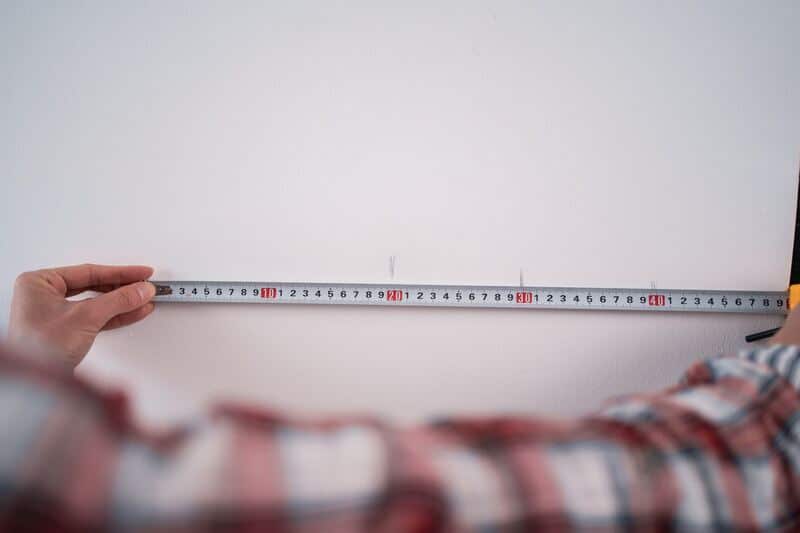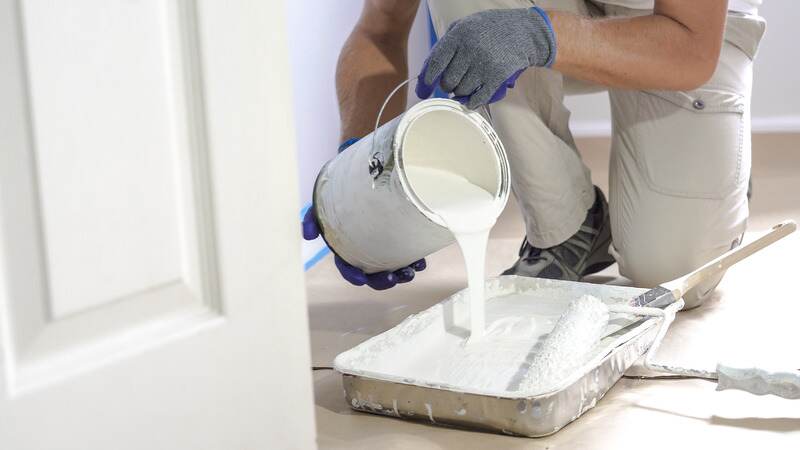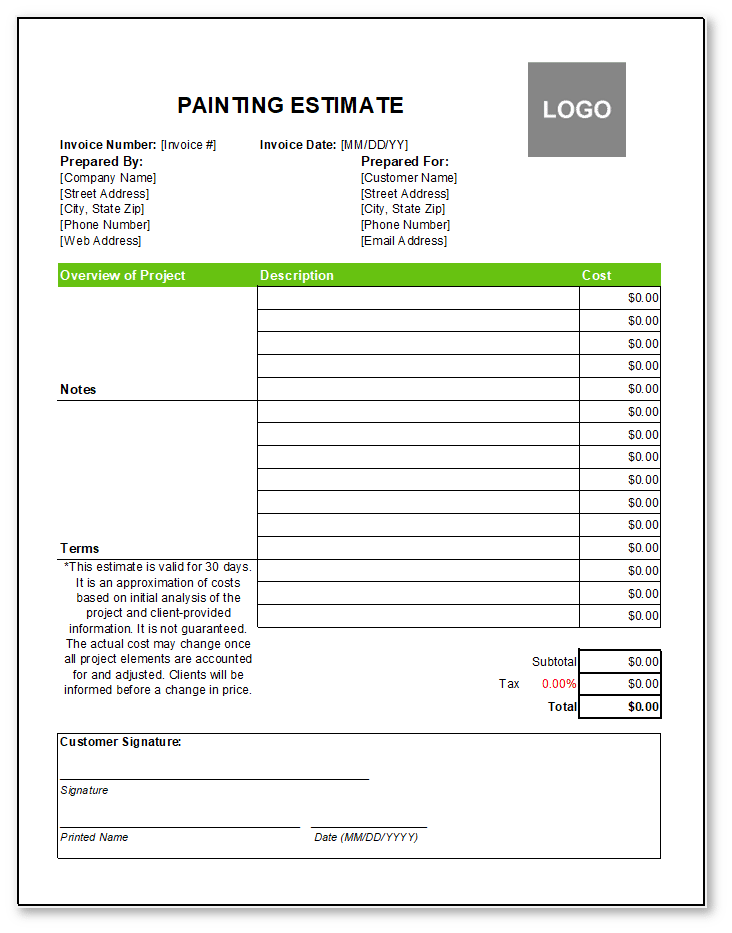In the world of professional painting, precision matters—not just with your brush, but with your numbers.
A spot-on estimate keeps your project running smoothly and on budget. A sloppy one can turn the job into a chaotic, budget-busting ordeal for everyone involved.
Here’s how to estimate a paint job like a pro. Discover seven easy steps that cover everything from measuring the space to factoring in materials and labor costs. Get the tools you need to create estimates that are as polished as your painting.
RELATED ARTICLE — How To Get a Painter’s License: Requirements and Top Tips
Step 1: Do Your Painting Job Pre-Check
Before you start crunching numbers, gather all the information you need. This pre-check stage sets the foundation for an accurate estimate.
Start by asking your client the right questions. What’s the timeline for the project? Will you be painting doors and window frames? Are there any special instructions or unique features to consider? Don’t be shy about asking for details. The more you know, the more accurate your estimate will be.
Next, inspect the site yourself. Look for any issues that might affect your work, like peeling paint or damaged surfaces. Note anything that might need extra attention or materials. Are there high ceilings that need special equipment? Is there furniture that needs to be moved or covered? These details can significantly impact your time and material needs.
Don’t forget to check local building codes and anything else that might affect how you can work. Some areas and organizations, like homeowners’ associations, have specific rules about paint types or colors, especially for exterior jobs.
For example, some historical districts have strict color guidelines, while other areas might require low-VOC paints for environmental reasons. Knowing the guidelines you’re working with upfront can save you from having to redo work or make last-minute changes.
Step 2: Measure the Space

Now it’s time to break out the tape measure. Accurate measurements are the backbone of a solid estimate.
Here’s how to price interior paint jobs:
- Find the wall surface area. Measure the room’s perimeter and multiply it by the room height.
- Measure unpaintable sections like windows and doors.
- Subtract these unpaintable areas from your total wall surface.
Don’t forget to add trims, baseboards, and ceilings if you’re painting those, too. These extras add up quickly, especially in rooms with lots of architectural details.
To put together an exterior house painting quote, follow similar steps:
- Measure the house’s perimeter and multiply by its height.
- Subtract the area of doors and windows.
- Account for any additional structures like garages or sheds if they’re part of the job.
How To Estimate a Paint Job by Square Feet
When working on how to estimate a paint job, a calculator always comes in handy. Let’s run through an example to illustrate how to estimate by square footage.
Say you’re painting a room that’s 10 feet by 12 feet, with 8-foot ceilings. The wall area would be:
(10 + 12 + 10 + 12) x 8 = 352 square feet
If there’s a 3×5 foot window and a 3×7 foot door, you’d subtract those areas:
(3 x 5) + (3 x 7) = 36 square feet
So your total paintable area would be:
352 – (3 x 5 + 3 x 7)
= 352 – 36
= 316 square feet
RELATED ARTICLE — How To Estimate a Masonry Job (in 7 Easy Steps)
Step 3: Estimate Painting Material Costs
With measurements in hand, it’s time to figure out your material costs. Consider questions like:
- Is it an interior or exterior job?
- Does the client want ceiling or trim painting?
- Is it new construction or a repaint?
- What colors and types of paint will you need?
The answers to all of these questions affect the cost of the project. You can also use a painting cost calculator to make things easier.
Interior Versus Exterior Painting Costs
Interior and exterior jobs have different considerations. One of the biggest variables is the cost of paint. Interior paint is usually cheaper but might need more coats. Exterior paint costs more but often covers better.
For interior jobs, plan on spending $20 to $50 per gallon of paint, or over $60 for high-end options. One gallon of paint typically covers 300 to 400 square feet. If you need primer, budget $30 to $70 per gallon of paint, keeping in mind that primer covers 200 to 300 square feet.
Exterior paint runs from $25 to $80 per gallon. It’s worth investing in quality paint for better coverage and fewer coats. One gallon of paint usually covers 250 to 400 square feet, but this varies based on the surface.
Don’t forget to factor in other materials like tape, brushes, and rollers. These add up, especially for larger jobs.
RELATED ARTICLE — How To Make an Estimate for Construction (in 7 Steps)
Step 4: Estimate Labor and Rental Costs

Labor is often your biggest expense, so estimate it carefully. First, calculate your total expected labor hours:
Number of people x number of hours = Total labor hours
Next, use this figure to calculate your labor costs:
Total labor hours x hourly labor cost = Total labor cost
For example, here’s the calculation if you have three painters costing you $25 per hour working for 20 hours:
3 painters x 20 hours = 60 total labor hours
60 hours x $25 per hour = $1,500 total labor cost
Be sure to account for prep work and cleanup time in your labor estimates. These tasks can take longer than you expect.
Don’t forget about equipment rentals. For short-term or one-time needs, renting often makes sense. For long-term or recurring needs, buying might be more cost-effective. Always factor in maintenance and storage costs when deciding whether to rent or buy.
Common rental items for painting jobs include:
- Heavy-duty pressure washers for exterior prep
- Paint sprayers for large areas
- Scaffolding or lifts for high spaces
RELATED ARTICLE — 10 Business Expense Categories You Need To Consider
Step 5: Account for Overhead and Profit Margin
Overhead costs are easy to overlook, but they’re crucial to your painting business’s ongoing health. They include things like office rent, insurance, and marketing expenses.
After tallying up yearly overhead costs, calculate your hourly overhead costs by dividing your yearly overhead costs by the number of billable hours you and your team work per year:
Total yearly overhead costs ÷ (number of employees x hours worked per week x 52 weeks) = Hourly overhead costs
For specific jobs, you can calculate overhead costs like this:
Hourly overhead costs x hours to complete the job = Overhead cost for the job
For example, if your yearly overhead is $50,000 and you have 5 employees working 40 hours a week, you have:
$50,000 ÷ (5 employees x 40 hours a week x 52 weeks) = $4.81 per hour in overhead costs
For a 60-hour job, your overhead would be:
$4.81 x 60 = $288.60
Now, let’s talk profit. To calculate your current profit margin, start by calculating your net income:
Total revenue – material costs – labor costs – overhead costs = Net income
Then you can find your profit margin using:
Net income / total revenue = Profit margin
Here’s how to apply your profit margin to a new job:
Total project material costs (including labor) + (total project material costs (including labor) x profit margin) = Total project pricing
Step 6: Create the Painting Estimate
Now it’s time to put it all together. When thinking about how to write a painting estimate for a job, be sure to include:
- A detailed outline of the project scope
- A breakdown of paint and materials
- The total cost, including labor, materials, overhead, and profit margin
- An expiration date for the estimate
Use a Painting Estimate Template
Consider using a template to make this process easier. Whether you use a pre-made template or create your own, make sure it includes:
- Business name and logo
- Contact information
- Client details
- A unique estimate number
Your estimate should be clear and professional. Avoid industry jargon your client might not be familiar with.
Here’s a painting estimate example for inspiration:
Step 7: Deliver the Estimate
The final step is getting the estimate to your client. Whether you’re sending it by email or delivering it in person, make sure it’s clear and professional.
Include a descriptive subject line if you’re emailing the estimate. Address the client by name and thank them for the opportunity to apply for the job. Give clear instructions on how to view and accept the estimate, and outline the next steps for moving forward.
Remember, your estimate is often your first chance to make a good impression on a potential client. A well-prepared, professional estimate can make the difference between landing the job and losing out to a competitor.
RELATED ARTICLE — How To Follow Up on an Estimate (with Email Templates)
Need To Estimate a Paint Job? Joist Can Help
Joist is your estimating and invoicing partner. The easy-to-use app empowers professional painters to create and deliver accurate estimates in just minutes.
Our mobile estimating tool puts more billable hours back into your week. Joist lets you build custom estimates, invoices, work orders, and more from any web-connected device.
